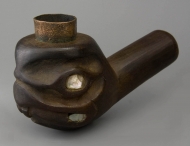Stylized head of a beaver
June 2014

Tlingit, an Eskimo tribe with its own culture, lives in British Columbia, high on the west coast of Canada. Like so many peoples they are fanatic smokers and not surprisingly they have given their pipes their own characteristics. Wood is generally used as raw material, cedar wood being the most common. Because this type of wood is flammable, their pipes are provided with a metal inner bowl. Sometimes this bowl is made of brass or copper, in other cases iron from, for example, gun barrels is reused. The woodwork is decorated with traditional carving, of which this pipe gives an example. In terms of style, the depiction looks a lot like the more southern Haida, but the technology is unmistakably Tlingit. Around the pipe bowl is the stylized head of a beaver with details accentuated with pieces of mother-of-pearl. Some museums in Canada have fantastic Tlingit pipes from the first half of the nineteenth century. These objects are primarily sculptures, in which the pipe bowl has been given a place and where a hole gave the opportunity to attach a stem to the pipe. Our relatively late piece is based on a more standard pipe with a streamlined shape that is comfortable to hold. For this reason, this pipe cannot be compared with those early pieces. Yet this sculptural expression is a formidable example in its own right of the different styles and decorations that can occur in the world of tobacco pipes.
Amsterdam Pipe Museum APM 21.930
Archive object of month